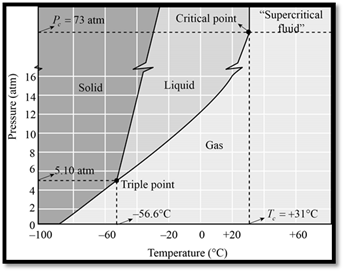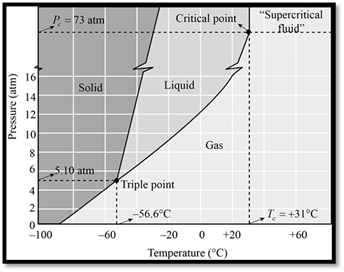
Concept explainers
(a)
Interpretation:
Density of the liquid carbon dioxide is greater or less than solid carbon dioxide has to be identified.
Concept introduction:
All three phases of
(a)
Answer to Problem 33PS
The density of liquid
Explanation of Solution
The phase diagram of

Figure 1
When seeing the phase diagram of
(b)
Interpretation:
Phase at which carbon dioxide at 5tm and
Concept introduction:
All three phases of
(b)
Answer to Problem 33PS
Explanation of Solution
The phase diagram of

Figure 1
When seeing the phase diagram of
In the phase diagram of
(b)
Interpretation:
Carbon dioxide can be liquefied at
Concept introduction:
All three phases of
(b)
Answer to Problem 33PS
Explanation of Solution
The phase diagram of

Figure 1
When seeing the phase diagram of
In the phase diagram of
Want to see more full solutions like this?
Chapter 12 Solutions
Chemistry & Chemical Reactivity
- The vapor pressure of benzene is 224 mmHg at 45 °C and 648 mmHg at 75 °C.(a) Find the enthalpy of vaporization of benzene, ∆Hvap (kJ/mol), assuming it is constant. You may also assume that ZV − ZL ≃ 1. B)arrow_forward1.Indium has a tetragonal unit cell for which the a and c lattice parameters are 0.459 and 0.495 nm, respectively. (a) If the atomic packing factor and atomic radius are 0.693 and 0.1625 nm, respectively, determine the number of atoms in each unit cell. (b) The atomic weight of indium is 114.82 g/mol; compute its theoretical density.arrow_forwardA metal X has an atomic radius of 0.126 nm. If the density and molar mass of X are 7.87 g cm3 and 55.85 g mol1, respectively. 1. (a) (i) Determine the number of atoms per unit cell and the crystal structure of metal X. (ii) Determine the volume of the unit cell. (ii) Determine its planar density in [100], [110] and [111] directions. (iv) Explain which direction would be the most possible slip direction when shear stress is applied. (b) Explain the role of matrix and reinforcement phase in a composite material.arrow_forward
- Lithium bromide crystalizes as shown (right) where the lithium ions are represented as white circles and the bromide ions are represented as filled circles. Give all answers to four significant figures. (a) What is the mass of one unit cell in grams? (b) If the density of LiBr is 3.464 g/mL, what is the edge length of the unit cell in pm? (c) Calculate the Li-Br distance in the crystal structure in pm.arrow_forward2. A closed vessel of volume 10.0 L initially contains 1.303 g of water and no water vapor. Please calculate the mass of liquid water remaining once the system reaches equilibrium at 30 degrees Celsius. The vapor pressure of water at that temperature is equal to 0.0418 atm.arrow_forwardA 5.30 g sample of solid MgSO, · 7H,0 was heated such that the water turned to steam and was driven off. Assuming ideal behavior, what volume would that steam occupy at 1.00 atm and 100.0 °C? V =arrow_forward
- A metal crystallizes in the face-cente red cubic crystal structure with a unit cell edge of 4.08 x 10 -8 cm. The density of the metal is 19.3 g/cc. (a) What is the mass, in grams, of a single atom of this element? (b) What is the atomic weight of the element (g/mol). (c) What is the radius, in cm, of an atom of the element?arrow_forwardRefer to the phase diagram below, and describe the phase changes (and the temperatures at which they occur) when CO2 is heated from -80° C to -20° C at (a) a constant pressure of 3 atm; (b) a constant pressure of 6 atm; (c) a constant pressure of 9 atmarrow_forwardA cubic unit cell contains manganese ions at the corners and fluoride ions at the center of each edge.(a) What is the empirical formula of this compound? Explain your answer.(b) What is the coordination number of the Mn3+ ion?(c) Calculate the edge length of the unit cell if the radius of a Mn3+ ion is 0.65 A.(d) Calculate the density of the compound.arrow_forward
- The phase diagram of a hypothetical substance is (a) Estimate the normal boiling point and freezing point ofthe substance. (b) What is the physical state of the substanceunder the following conditions? (i) T = 150 K, P = 0.2 atm;(ii) T = 100 K, P = 0.8 atm; (iii) T = 300 K, P = 1.0 atm.(c) What is the triple point of the substance?arrow_forwardWhich type of intermolecular force accounts for each ofthese differences? (a) CH3OH boils at 65 °C; CH3SH boils at6 °C. (b) Xe is a liquid at atmospheric pressure and 120 K,whereas Ar is a gas under the same conditions. (c) Kr,atomic weight 84 amu, boils at 120.9 K, whereas Cl2, molecularweight about 71 amu, boils at 238 K. (d) Acetone boilsat 56 °C, whereas 2-methylpropane boils at -12 °C.arrow_forward(a) Why is the heat of fusion (ΔHfus) of a substance smaller than its heat of vaporization (ΔHvap)?(b) Why is the heat of sublimation (ΔHsubl) of a substance greater than its ΔHvap?(c) At a given temperature and pressure, how does the magnitude of the heat of vaporization of a substance compare with that of its heat of condensation?arrow_forward
 Chemistry: The Molecular ScienceChemistryISBN:9781285199047Author:John W. Moore, Conrad L. StanitskiPublisher:Cengage Learning
Chemistry: The Molecular ScienceChemistryISBN:9781285199047Author:John W. Moore, Conrad L. StanitskiPublisher:Cengage Learning
